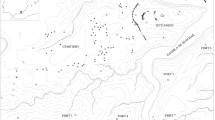Abstract
The Southern Corridor of bishopric district was uncovered in early 1920s as the first Romanesque remains in the 3rd Courtyard of the Prague Castle. Based on historical context it likely originates from 11th − 12th century. To benchmark this estimate, radiocarbon dating of charcoals found in its mortars was performed. The results support the previous age estimate and suggest an ongoing building activity on site such as raising cascade walls at least till 14th − 16th century.



Similar content being viewed by others
References
Arnold JR, Libby WF (1949) Age determinations by radiocarbon content: checks with samples of known age. Science 110:678–680
Hajdas I (2009) Applications of radiocarbon dating method. Radiocarbon 51:79–90
Jull AJT (2013) Some interesting and exotic applications of carbon-14 dating by accelerator mass spectrometry. J Phys Conf Ser 436:012083
Labeyrie J, Delibrias G (1964) Dating of old mortars by the carbon-14 method. Nature 201:742
Hale J, Heinemeier J, Lancaster L, Lindroos A, Ringbom Å (2003) Dating ancient mortar - Although radiocarbon dating is usually applied to organic remains, recent work shows that it can also reveal the age of sonic inorganic building materials. Am Sci 91:130–137
Hajdas I, Lindroos A, Heinemeier J, Ringbom à (2017) Preparation and dating of mortar samples – mortar dating inter-comparison study (MODIS). Radiocarbon 59:1845–1858
Daugbjerg TS, Lindroos A, Heinemeier J, Ringborn Ã, Barrett G, Michalska D, Hajdas I, Raja R, Olsen A (2021) A field guide to mortar sampling for radiocarbon dating. Archaeometry 63:1121–1140
Maříková-Kubková J, Herichová I (2009) Archeologický atlas Pražského hradu I. [The archaeological atlas of Prague castle I., in Czech] Archeologický ústav AV ČR, Praha. Castrum Pragense, 10. ISBN 978-80-87365-27-4
Maříková-Kubková J, Herichová I (2020) Svědkové 20. století, výzva pro 21. století. Význam a trvalá udržitelnost archeologických areálů Pražského hradu. [Witnesses of the 20th century - a challenge for the 21st century: The importance and the sustainable preservation of the archaeological areas of Prague Castle. In Czech]. In: Bisták P, Maříková-Kubková J, Válová K (Eds) Zborník príspevkov k 70. narodeninám Petra Baxu. Pamiatkový úrad Slovenskej republiky, Bratislava, pp 167–177. ISBN 978-80-89175-91-8
Maříková-Kubková J, Foltýn D, Eben D (2019) Pražská katedrální kapitula a klášter kostela pražského – historie a podoba kapitulního okrsku v letech 1000–1350 [Prague Cathedral Chapter and Monastery of the Church of Prague – history and appearance of the chapter district in 1000–1350 AD. In Czech]. In: Maříková-Kubková J et al (Eds) Katedrála viditelná a neviditelná I. Průvodce tisíciletou historií katedrály sv. Víta, Václava, Vojtěcha a Panny Marie na Pražském hradě. I. díl. Hilbertinum – Společnost Kamila Hilberta, z. s., and Archeologický ústav AV ČR, v. v. i., Praha, pp 90–119. ISBN 978-80-905659-0-6, ISBN 978-80-7581-010-6
Maříková-Kubková J, Herichová I, Válek J, Suchý M, Dvořák V, Kozáková R, Kočár P, Skružná O, Kozlovcev P, Eben D (2022) Otázka stavebního vývoje, patrocinia a funkce románské kaple na III. nádvoří. [On the building history, patrociny and function of Romanesque chapel on the 3rd courtyard, in Czech]. In print
Svetlik I, Jull AJT, Molnár M, Povinec P, Kolář T, Demján P, Pachnerova Brabcova K, Brychova V, Dreslerova D, Rybnicek M, Simek P (2019) The best possible time resolution: how precise could a radiocarbon dating method be? Radiocarbon 61:1729–1740
Šimek P, Megisová N, Bemš J (2019) Preparation of wood, charcoal and bone collagen micro samples using automat for AMS radiocarbon dating. Radiat Prot Dosimetry 186:433–436
Longin R (1971) New method of collagen extraction for radiocarbon dating. Nature 230:241–242
Orsowszki G, Rinyu L (2015) Flame-sealed tube graphitization using zinc as the sole reducing agent: precision improvement of EnvironMicadas 14 C measurements on graphite targets. Radiocarbon 57:979–990
Wacker L, Christl M, Synal H-A (2010) Bats: A new tool for AMS data reduction. Nucl Instrum Meth B 268:976–979
Bronk Ramsey C (2009) Bayesian analysis of radiocarbon dates. Radiocarbon 51:337–360
Reimer P, Austin W, Bard E et al (2020) The IntCal20 Northern Hemisphere radiocarbon age calibration curve (0–55 cal kBP). Radiocarbon 62:725–757
Bronk Ramsey C (2017) Methods for summarizing radiocarbon datasets. Radiocarbon 59:1809–1833
Pachnerová Brabcová K, Krofta T, Valášek V, Suchý V, Kundrát P, Šimek P, Kozlovec P, Kotková K, Fialová A, Povinec PP, Válek J, Světlík I (2022) Radiocarbon dating of charcoals from historical mortars from Týřov and Pyšolec castles. Radiat Prot Dosimetry. DOI: https://doi.org/10.1093/rpd/ncac119
Pachnerová Brabcová K, Kundrát P, Petrová M, Krofta T, Suchý V, Valášek V, John D, Kozlovcev P, Kotková K, Fialová A, Válek J, Svetlik I, Povinec PP (2022) Charcoals as indicators of historical mortar age of medieval Czech castle Pyšolec. Nucl Instrum Meth B 528:8-14. DOI: 10.1016/j.nimb.2022.07.015
Bronk Ramsey C, Van der Plicht J, Weninger B (2001) ‘Wiggle matching’ radiocarbon dates. Radiocarbon 43:381–389
Acknowledgements
This work was supported by the Research, Development and Education Operational Programme, Ministry of Education, Youth and Sports, under the project „Ultra-trace isotope research in social and environmental studies using accelerator mass spectrometry“, Reg. No. CZ.02.1.01/0.0/0.0/16_019/0000728, and by Czech Ministry of Culture, under the project „Possibilities of radiocarbon dating of historic mortars“, No. DG20P02OVV028.
Author information
Authors and Affiliations
Corresponding author
Ethics declarations
Conflict of interest
The authors declare that they have no known competing financial interests or personal relationships that could have appeared to influence the work reported in this paper.
Additional information
Publisher’s note
Springer Nature remains neutral with regard to jurisdictional claims in published maps and institutional affiliations.
Rights and permissions
Springer Nature or its licensor holds exclusive rights to this article under a publishing agreement with the author(s) or other rightsholder(s); author self-archiving of the accepted manuscript version of this article is solely governed by the terms of such publishing agreement and applicable law.
About this article
Cite this article
Kundrát, P., Maříková-Kubková, J., Herichová, I. et al. Radiocarbon dating of mortar charcoals from romanesque Southern Corridor, Prague Castle. J Radioanal Nucl Chem 332, 1469–1474 (2023). https://doi.org/10.1007/s10967-022-08577-7
Received:
Accepted:
Published:
Issue Date:
DOI: https://doi.org/10.1007/s10967-022-08577-7




